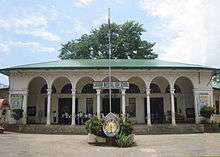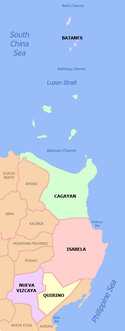Tuguegarao
Tuguegarao, officially the City of Tuguegarao (Ibanag: Siyudad nat Tugegaraw; Itawit: Siyudad yo Tugegaraw; Ilocano: Siudad ti Tuguegarao; Tagalog: Lungsod ng Tuguegarao [tʊgɛ̝gäˈɾɐw]), is a 3rd class component city and capital of the province of Cagayan, Philippines. According to the 2015 census, it has a population of 153,502 people,[3] making it the most populous city in Cagayan Valley and Northeastern Luzon.
Tuguegarao | |
|---|---|
| City of Tuguegarao | |
  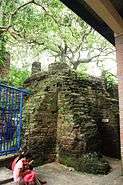 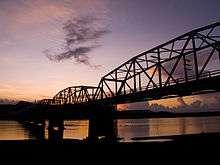  From top, clockwise: Central Business District along Bonifacio Street; Bagumbayan horno (kiln) ruins; St. Peter Metropolitan Cathedral; Buntun Bridge, the country's longest river bridge; Ermita de Piedra de San Jacinto (Stone Chapel of St. Hyacinth) | |
 Seal | |
| Nickname(s): Premier Ibanag City | |
| Anthem: Tuguegarao City Hymn | |
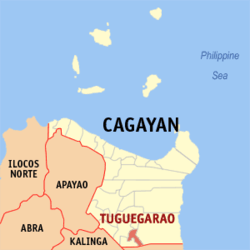 Map of Cagayan with Tuguegarao highlighted | |
OpenStreetMap 
| |
.svg.png) Tuguegarao Location within the Philippines | |
| Coordinates: 17°37′N 121°43′E | |
| Country | |
| Region | Cagayan Valley (Region II) |
| Province | Cagayan |
| District | 3rd District |
| Founded | May 9, 1604 |
| Cityhood | December 18, 1999 |
| Barangays | 49 (see Barangays) |
| Government | |
| • Type | Sangguniang Panlungsod |
| • Mayor | Jefferson P. Soriano |
| • Vice Mayor | Bienvenido C. de Guzman, II |
| • Congressman | Joseph L. Lara |
| • City Council | Councilors
|
| • Electorate | 90,462 voters (2019) |
| Area | |
| • Total | 144.80 km2 (55.91 sq mi) |
| Population (2015 census)[3] | |
| • Total | 153,502 |
| • Density | 1,100/km2 (2,700/sq mi) |
| • Households | 32,674 |
| Demonym(s) | Tuguegaraoeño (masculine) Tuguegaraoeña (feminine) |
| Economy | |
| • Income class | 3rd city income class |
| • Poverty incidence | 5.99% (2015)[4] |
| • Revenue (₱) | 743,495,308.47 (2016) |
| Time zone | UTC+8 (PST) |
| ZIP code | 3500 |
| PSGC | |
| IDD : area code | +63 (0)78 |
| Climate type | tropical monsoon climate |
| Native languages | Ibanag Ilocano Tagalog |
| Numbered highways |
|
| Major religions | Roman Catholicism |
| Feast date | August 16 |
| Catholic diocese | Archdiocese of Tuguegarao |
| Patron saint | St. Hyacinth of Poland |
| Website | www |
A major urban center and primary growth center in the Northeastern Luzon, it is the regional center of Cagayan Valley (Region II) and also its regional institutional and administrative center.[5] One of the fast emerging cities in the Philippines, the city is a convergence area for the provinces of Cagayan, Kalinga, Apayao and northern Isabela.
Dubbed as the “Gateway to the Ilocandia and the Cordilleras,”[6] the city is located on the southern border of the province where the Pinacanauan River empties into the Cagayan River. It is surrounded by the Sierra Madre Mountains to the east, Cordillera Mountains to the west, and the Caraballo Mountains to the south.
The highest temperature ever recorded in the Philippines—42.2 °C (108.0 °F)—hit Tuguegarao on August 19, 1912[7] and May 11, 1969.[8][9]
Etymology
There are several legends about the origin of the name. One is a species of palm tree called taraw in the area and another is garao in reference to the "swift river current."[10]
The most accepted version is the Ibanags' reply to the Spaniards when the latter asked for the name of the place — Tuggi gari yaw ("this was cleared by fire").[10]
On the other hand, historical evidence that might provide clues to the origin of the city's name comes from the fact that in 1591, the place was listed as a Spanish encomienda, which was originally a pre-colonial settlement called Tubigarao.[11]
History
Tuguegarao was founded on May 9, 1604 as a "mission-pueblo" with the new vicar Fray Tomas Villa, O.P. initiating the construction of a temporary church housing Sts. Peter and Paul as patron saints. In the 1720s, Father Antonio Lobato, O.P. developed a layout of street network together with the construction of the cathedral. In 1839, the provincial capital was transferred to Tuguegarao from Lal-lo as the Cagayan-Manila road opened which spurred socio-economic progress.[10]
The town was occupied by American troops on December 12, 1899. Drastic improvements in Tuguegarao were discerned over the course of provincial administrations—the first Provincial Capitol was completed in 1909, a town hall and public market were built, the provincial high school—Cagayan High School—was founded in a former private residence, and the Cagayan Valley College of Arts & Trades was founded by American educator Claude Andrews.[10]
During World War II, the city and its airfield of some significance was captured by the Japanese Imperial Army on December 12, 1941 as part of the Japanese invasion of Aparri. The General Headquarters of the Philippine Commonwealth Army, Philippine Constabulary and the USAFIP-NL units was activated on 1942 to 1946 and stationed in Tuguegarao.
Sitio Capatan was elevated into a barrio (or barangay) of Tuguegarao on April 3, 1959, by Republic Act No. 2107.[12]
In 1975, Tuguegarao was declared as the capital and seat of the regional government of Cagayan Valley (Region II) being the region's geographic center with adequate facilities and amenities needed by such. Multistory buildings were constructed in the poblacion greatly changing Tuguegarao's skyline in the 1980s and 1990s.
Hotel Delfino siege
On March 4, 1990, former colonel and suspended Cagayan governor Rodolfo Aguinaldo and his 200 armed men seized Hotel Delfino, located in the town poblacion, accused of supporting the December coup attempt against the Aquino government.[13] Brigadier General Oscar Florendo, three aides, Local Government Secretary Luis Santos and several others were held hostage for hours. A gunfight was launched to kill Aguinaldo and his men; Florendo was wounded and dead in the shootout, 10 were killed in a checkpoint shootout and three more in a gasoline station.[14] Aguinaldo was slightly wounded in a car gunfight but eventually escaped and hid in the mountains.
Cityhood
Tuguegarao became a component city after a plebiscite held on December 18, 1999. Randolph Ting was the first mayor of the new city. On July 2, 2007, Delfin Telan Ting was elected as the second mayor. After the 25-year political domination of the Tings, former police general Jefferson Soriano won over re-electionist Delfin Ting in the 2013 local elections.[15]
Geography
Tuguegarao's location is in the southern portion of the province. The city is bordered by Iguig to the north; to the west by the Cagayan River and Solana; Peñablanca to the east; and to the south by Enrile and San Pablo, Isabela. The river delta city is almost encapsulated by the Cagayan River in the western and southern side, which explains for its northward expansion, and the Pinacanauan River, a tributary of Cagayan River, in the eastern part. Small bodies of waters are found in the city, such as the Balzain Creek which spans the barangays of Caritan Sur and Balzain. Currently, the creek is continuously drying up due to eutrophication and the uncontrollable growth of water lilies.
Historically, the town was inhabited by Irayas and Itawes who lived and mainly relied on fishing, farming, hunting and livestock raising. In addition, ancient natives have ventured on weaving cloth and making of household and farm implements.[16]
Cagayan is divided into three congressional districts, wherein the city is included in the Third District together with the other 6 southern municipalities.[17]
The city is located 483 kilometres (300 mi) north of Manila, which is an hour by plane and ten hours of land travel.[17] It is also 77 kilometres (48 mi) from Ilagan, 127 kilometres (79 mi) from Santiago City, 164 kilometres (102 mi) from Cabarroguis, 188 kilometres (117 mi) from Bayombong and 318 kilometres (198 mi) from Basco.
Barangays
The city comprises 49 barangays.[18] The three most populous are Ugac Sur, Ugac Norte and Cataggamman Nuevo. More than half are classified as urban barangays with some having a combination of commercial, residential and agricultural sites. Rural barangays are mostly agricultural territories.
| Barangay | Classification | Population (2015) | Barangay | Classification | Population (2015) |
|---|---|---|---|---|---|
| Annafunan East | Urban | 4,207 | Centro 10 (Riverside) | Urban | 2,282 |
| Annafunan West | Urban | 3,310 | Centro 11 (Balzain East) | Urban | 2,990 |
| Atulayan Norte | Urban | 3,578 | Centro 12 (Balzain West) | Urban | 2,391 |
| Atulayan Sur | Urban | 4,404 | Dadda | Rural | 1,167 |
| Bagay | Rural | 3,393 | Gosi Norte | Rural | 1,016 |
| Buntun | Urban | 4,373 | Gosi Sur | Rural | 1,297 |
| Caggay | Urban | 7,261 | Larion Alto | Rural | 1,856 |
| Capatan | Rural | 3,337 | Larion Bajo | Rural | 2,345 |
| Carig Norte | Rural | 2,267 | Leonarda | Urban | 2,503 |
| Carig Sur | Urban | 4,536 | Libag Norte | Urban | 2,384 |
| Caritan Centro | Urban | 4,872 | Libag Sur | Urban | 2,708 |
| Caritan Norte | Urban | 3,093 | Linao East | Rural | 6,939 |
| Caritan Sur | Urban | 1,833 | Linao Norte | Rural | 3,005 |
| Cataggaman Nuevo | Urban | 8,161 | Linao West | Rural | 1,665 |
| Cataggaman Pardo | Rural | 3,292 | Namabbalan Norte | Rural | 1,433 |
| Cataggaman Viejo | Rural | 4,246 | Namabbalan Sur | Rural | 746 |
| Centro 01 (Bagumbayan) | Urban | 1,158 | Pallua Norte | Rural | 2,450 |
| Centro 02 | Urban | 553 | Pallua Sur | Rural | 2,683 |
| Centro 03 | Urban | 339 | Pengue-Ruyu | Urban | 5,629 |
| Centro 04 | Urban | 566 | San Gabriel | Urban | 6,828 |
| Centro 05 | Urban | 1,126 | Tagga | Rural | 1,346 |
| Centro 06 | Urban | 195 | Tanza | Urban | 5,665 |
| Centro 07 | Urban | 262 | Ugac Norte | Urban | 9,615 |
| Centro 08 | Urban | 125 | Ugac Sur | Urban | 10,858 |
| Centro 09 | Urban | 969 | TOTAL | 153,502 | |
Climate
Tuguegarao experiences a tropical climate, with only a slight difference between summer and winter temperatures, and high year-round humidity. The average temperature during March and April is 38 °C (100 °F),[19][20] one of the highest in the country.
On August 19, 1912 and May 11, 1969,[7][9] the highest temperature in the Philippines was recorded in Tuguegarao at 42.2 °C (108.0 °F).[8] Thus, the city was tagged as the "Hottest City in the Philippines". Unusually, in months—usually lasts from December to February—where the cool northeast monsoon or locally as amihan surges, temperatures in the city drop to as low as 15 °C (59 °F)—in 2017[21]—especially in early mornings. Locals parallel the chills felt with that in Baguio.[22]
| Climate data for Tuguegarao (1981–2010, extremes 1903–2012) | |||||||||||||
|---|---|---|---|---|---|---|---|---|---|---|---|---|---|
| Month | Jan | Feb | Mar | Apr | May | Jun | Jul | Aug | Sep | Oct | Nov | Dec | Year |
| Record high °C (°F) | 37.2 (99.0) |
38.4 (101.1) |
40.0 (104.0) |
42.2 (108.0) |
42.2 (108.0) |
41.7 (107.1) |
41.0 (105.8) |
39.4 (102.9) |
38.9 (102.0) |
38.5 (101.3) |
37.8 (100.0) |
38.5 (101.3) |
42.2 (108.0) |
| Average high °C (°F) | 28.4 (83.1) |
30.5 (86.9) |
33.1 (91.6) |
35.4 (95.7) |
35.8 (96.4) |
35.1 (95.2) |
33.9 (93.0) |
33.5 (92.3) |
32.9 (91.2) |
31.4 (88.5) |
29.6 (85.3) |
27.8 (82.0) |
32.3 (90.1) |
| Daily mean °C (°F) | 23.7 (74.7) |
24.9 (76.8) |
27.0 (80.6) |
29.0 (84.2) |
29.5 (85.1) |
29.3 (84.7) |
28.6 (83.5) |
28.3 (82.9) |
27.9 (82.2) |
26.7 (80.1) |
25.3 (77.5) |
23.6 (74.5) |
27.0 (80.6) |
| Average low °C (°F) | 18.9 (66.0) |
19.3 (66.7) |
20.9 (69.6) |
22.6 (72.7) |
23.2 (73.8) |
23.4 (74.1) |
23.2 (73.8) |
23.2 (73.8) |
22.8 (73.0) |
22.0 (71.6) |
21.0 (69.8) |
19.4 (66.9) |
21.7 (71.1) |
| Record low °C (°F) | 12.0 (53.6) |
12.9 (55.2) |
14.0 (57.2) |
16.3 (61.3) |
17.5 (63.5) |
17.0 (62.6) |
17.0 (62.6) |
19.0 (66.2) |
17.6 (63.7) |
14.8 (58.6) |
12.8 (55.0) |
12.0 (53.6) |
12.0 (53.6) |
| Average rainfall mm (inches) | 32.7 (1.29) |
27.3 (1.07) |
28.6 (1.13) |
47.2 (1.86) |
128.2 (5.05) |
157.5 (6.20) |
195.3 (7.69) |
247.1 (9.73) |
221.4 (8.72) |
298.5 (11.75) |
230.0 (9.06) |
122.3 (4.81) |
1,736.2 (68.35) |
| Average rainy days (≥ 0.1 mm) | 8 | 6 | 5 | 6 | 11 | 12 | 15 | 15 | 14 | 15 | 15 | 12 | 134 |
| Average relative humidity (%) | 80 | 77 | 74 | 70 | 70 | 70 | 71 | 72 | 73 | 75 | 78 | 80 | 74 |
| Mean monthly sunshine hours | 135.4 | 174.9 | 218.3 | 253.3 | 230.9 | 231.9 | 223.2 | 172.0 | 158.4 | 142.2 | 119.0 | 128.2 | 2,187.7 |
| Source 1: PAGASA[23][24] | |||||||||||||
| Source 2: Deutscher Wetterdienst (sun, 1961–1990)[25][26] | |||||||||||||
Demographics
|
| |||||||||||||||||||||||||||||||||||||||||||||
| Source: Philippine Statistics Authority[3][27][28][29] | ||||||||||||||||||||||||||||||||||||||||||||||
In the 2015 census, the population of Tuguegarao was 153,502 people[3] with a density of 1,100 inhabitants per square kilometre or 2,800 inhabitants per square mile. It is the most populous and densest city in the Cagayan Valley region. Most of the inhabitants are Ilocanos, Ibanags and Itawes. Some are of Chinese and Indian descent.
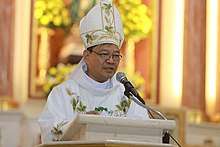
Religion
Due to a history of Spanish and other foreign missions, Christianity, in the form of Roman Catholicism, is the predominant religion in Tuguegarao. The remainders are divided with Islam and various Protestant faiths such as Baptist, Methodists, Non-denominational, Iglesia ni Cristo, The Church of Jesus Christ of Latter Day Saints (Mormon), Jehovah's Witnesses, Seventh-day Adventist and other Christian groups. The present Roman Catholic Archdiocese was chiseled from the Archdiocese of Nueva Segovia formerly located in Lal-lo (Nueva Segovia). It was initially created as a diocese on April 10, 1910 and elevated as an Archdiocese by Pope Paul VI on September 21, 1974. It has jurisdiction over suffragan bishops of Bayombong, Ilagan and Batanes.
The seat of the Roman Catholic Archdiocese is at St. Peter Metropolitan Cathedral, one of the largest churches in the region.
Economy
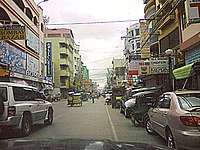

Within the past three decades, its economy gradually shifted from agriculture to trading, commerce and services. The shift was ushered by Tuguegarao's role as the Regional Government Center and Center of Commerce in Northern Luzon.[30] In early 2016, Tuguegarao City was named as one of the ten emerging cities in the 2015 Next Wave Cities report, conducted by Department of Science and Technology - Information and Communications Technology Office (DOST-ICTO).[31]
On June 30, 2020, the Department of Information and Communications Technology (DICT), in partnership with the IT and Business Process Association of the Philippines (IBPAP) and Leechiu Property Consultants (LPC), named Tuguegarao as one of the 25 "digital cities" poised to be prospect growth areas of the information technology and business process management (IT-BPM) sector in the country by 2025.[32]
Currently, Tuguegarao City has two major public markets, namely, the Don Domingo Public Market — located in the upper part of Poblacion serving as the convergence of agricultural and aquatic products from neighboring towns and provinces — and the Tuguegarao City Commercial Center — formerly known as Mall of the Valley and is located at the Central Business District, receiving the highest daily foot traffic.
Retail and business process outsourcing
Large retail operators have shown significant interest to the growth and increase of land value in cities throughout the Philippines. They are seen as highly developed urban centers where a lot of economic activities take place, and is important to urbanization and development. Tuguegarao is eyed as a center of exponential growth for commerce, industry and service, strengthening its stature as the capital of the Cagayan Valley Region.
SM Prime, the largest retail operator in the country, opened SM Center Tuguegarao Downtown on October 12, 2017, its first mall in Cagayan. Plans have also been made for the construction of another SM mall[33] with clearing operations and fencing of the SM City Tuguegarao site in March 2019, anticipating opening by 2021.[34][35]
On July 26, 2018,[36] rival Robinsons Land Corporation opened the mixed-use complex shopping mall Robinsons Place Tuguegarao as the first full-service mall in Cagayan,[37] including a Go Hotels branch,[38] the first in the region. A few kilometers away from Robinsons Place Tuguegarao, DoubleDragon Properties, a subsidiary of SM Investments Corporation, started constructing CityMall Tuguegarao at last quarter of 2017 and planned to open December 2019.
Other notable shopping centers include the Tuguegarao City Commercial Center, formerly known as the Mall of the Valley; FCI Citimall, the first shopping mall in Northern Luzon; Brickstone Mall; Primark Town Center Tuguegarao, former site of Paseo Reale Mall; Unitop Mall Tuguegarao; Mart One Department Store and more.
Following the opening of 7 Eleven stores in Nueva Vizcaya, and Isabela provinces, the Philippine Seven Corporation expanded its reach to the Cagayan with its two branches in the city at College Avenue, near University of Cagayan Valley and at the new Valley Hotel Tower Mall in Balzain.[39]
The city has seen a significant growth of auto-hub companies with the presence of car showrooms in the city. Car brands such as Mitsubishi, Hyundai, and Toyota have set up their dealerships in the different parts of the city, mostly located along the major highways of the urbanity. The largest of which is from Toyota located at Carig Sur near the city hall.
The City Government of Tuguegarao, through the city's Information and Communications Technology (ICT) Council hosted a meeting with IT-BPO companies Sitel Philippines Inc. and Lee Chiu Property Consultants, Inc. in September 2018 to discuss the possibilities of locating their companies in the city. Initial steps have been made for the establishment of an IT park and a township where BPO companies could locate.[40][41]
Banking and real estate
Tuguegarao City, as the seat of the regional capital of Cagayan Valley, houses the regional headquarters of the Bangko Sentral ng Pilipinas located at the Regional Government Center in Carig Sur. As of 2019, a total of 53 banks are operating in the city such as BPI, BDO, Chinabank, RCBC, EastWest, UnionBank, Robinsons Bank, PNB, Bank of Commerce, Landbank, UCPB, Philippine Postal Savings Bank and others.
Major real estate developers Ayala Land — Avida Settings Tuguegarao — and Vista Land — Camella Tuguegarao and the expansion of Camella Cagayan (soon Camella Cagayan Trails) — are constructing their housing developments in Cagayan Valley.
The North Gateway Business Park is an 18-hectare (44-acre) mixed-use township development project located in Barangay Carig Sur, near the Regional Government Center. Launched on February 4, 2020 by real estate developer DataLand, it will feature a mixed-use superblock of retail shops, transport terminal, hotel and residential condominiums and a business park for BPO companies, financial institutions and major corporations.[42][43]
Local government
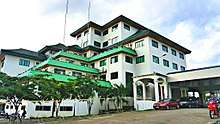
Tuguegarao City is governed by a city mayor, designated as local chief executive, and by a city council, composed of the vice mayor and the city councilors, as the legislative body, in accordance with the Local Government Code.[44] They are voted to office through an election, held every after three years. As a component city, the provincial government of Cagayan has political jurisdiction over local transactions of the city government.
On February 10, 2017, then City Mayor Jefferson P. Soriano stepped down from office following an order from the Ombudsman to dismiss him for grave misconduct. Soriano voluntarily called the Department of Interior and Local Government (DILG) to facilitate the turn over of the mayoralty office to then Vice Mayor Bienvenido de Guzman II.[45] After about seven months, following the order of the Court of Appeals Fourth Division (CA) for "immediate" reinstatement of Mayor Jefferson P. Soriano, on September 6, 2017, Soriano took oath of office. The CA disagreed to the Ombudsman's dismissal order—stating that he committed grave misconduct—and that the mayor only committed simple misconduct. According to the decision, he should only be penalized with three months suspension instead of dismissal from service.[46]
| Position | Name |
|---|---|
| District Representative (3rd Legislative District of the Province of Cagayan) |
Joseph L. Lara |
| Chief Executive of the City of Tuguegarao | Mayor Jefferson P. Soriano |
| Presiding Officer of the City Council of Tuguegarao | Vice Mayor Bienvenido C. De Guzman II |
| Councilors of the City of Tuguegarao | Maila Rosario T. Que |
| Imogen Claire M. Callangan | |
| Gilbert S. Labang | |
| Danilo L. Baccay | |
| Ronald Ortiz | |
| Arnel T. Arugay | |
| Mary Marjorie M. Chan | |
| Winnoco R. Abraham | |
| Grace B. Arago | |
| Raymund P. Guzman | |
| Karina S. Gauani | |
| Victor Herbert Perez | |
Culture
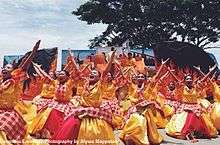
The Afi Festival is an annual festival every August, celebrated in commemoration of the city's patron saint, San Jacinto de Polonia whose feast day falls on August 16.[48] It came from the Ybanag word afi, meaning fire.[49]
The concept of the "Afi" started in 2014, renaming the former Pav-vurulun Festival. It reiterates and reaffirms the origins of the city's name. Stories say the place where the city center now stands was once “a wilderness that was cleared by fire” through kaingin (slash and burn farming).[48] The main event of the celebration is its opening day, where thousands of students convene for a field demonstration at night as torchbearers. In 2017, 3500 students from Cagayan National High School and Cagayan State University - College of Human Kinetics danced with torches at the sports complex. The city is attempting to beat Indonesia's world record of 3,777 torchbearers in the festival's next edition.[50]
Other highlights of the weeklong celebration include the street dancing competition and drum and lyre competition, where various elementary and secondary schools participate, everyone clad in vibrant costumes and props. Both are usually held at the city's central business district on Bonifacio Street (Calle Commercio). Other events include the Bangkarera competition, a rowing competition in two categories which aims to promote sustainable fishing along the Pinacanauan River, which flows to the Cagayan River, a pansit festival featuring a pansit-eating contest, a Nuang Karera (Carabao race), a Kabayu Karera (horse race), among others.[51]
Before the additions and revisions to the native festival, there was Maskota Festival. Also called the Dance of Lovemaking, it features Maskota, a wedding dance prevalent in the provinces of Cagayan and Isabela, with movements described as "spontaneous, lively and extravagantly expressive." It was danced to the rhythm of the verso with the sincosinco accompaniment. Back then, indigenous materials were utilized for the costumes. Materials come from various local harvests such as coconut sprouts, betel nuts, corn leaves and atchuetes, which serves as natural coloring.[52]
Pancit Batil Potun, widely known as Pancit Batil Patung, is a popular local noodle dish which directly translates to "beaten egg on top." Several panciterias mushroom in all the city's corners, each with distinct styles of cooking and ingredients—miki, egg, minced carabao meat, vegetables and other specific toppings of choice.[53] The city is also known for its own version of longganisa characterized with its salty and garlicky taste with variations using either pork or carabao meat.[54]
Tourism

The Cagayan Museum and Historical Research Center houses an extensive collection of various artifacts and antiques of the province. In addition to animal fossils found in the valley, it houses extensive data on the discovery of Callao Man by the National Museum. Formerly located in the Cagayan Provincial Capitol Complex, it has moved to the renovated historic provincial jail known as Tribunal de Tuguegarao.[55] In front of the provincial museum is the century-old Rizal Park which is also refurbished.[56]
Tuguegarao boasts elaborate Spanish-built churches such as the Ermita de Piedra de San Jacinto, known to locals as the San Jacinto Church which houses the city's patron saint. It is an elevated chapel built by Dominican friars in 1604 regarded as the oldest brick structure in the city. The St. Peter Metropolitan Cathedral is the biggest Spanish colonial church in Cagayan Valley which was construction from 1761 to 1767 under the supervision of Fr. Antonio Lobato, OP. It is the seat of the Archdiocese of Tuguegarao. Both churches underwent reconstruction due to damages brought by World War II.
Located in Barangay Centro 09, often called Bagumbayan by locals, is the Horno ruins,[57] a Spanish-era brick kiln used to fire bricks for colonial structures including those in the Cathedral and San Jacinto Church.
St. Paul University Philippines was founded in 1907 as Colegio de San Pablo With the arrival of the Sisters of St. Paul of Chartres in Cagayan Valley. It served as a military garrison and hospital of the Japanese during the World War. Throughout the years, it has since become identified internationally having been the first private university in the Philippines to be ISO 9001 certified in 2000 by TÜV Rheinland.[58]
South of the city is the Buntun Bridge, one of the longest bridges in the country spanning 1.369 km (0.851 miles) across the Cagayan River, the longest and largest river in the Philippines. Construction began in 1960 and was opened to traffic in 1969, linking the city to the second and third district municipalities of Cagayan and Apayao.
While tourist spots are sparse in the city, it has become the usual jump-off point of tourists to other destinations in the province such as the Callao Cave and Calvary Hills in neighboring towns Peñablanca and Iguig respectively.[59]
Infrastructure
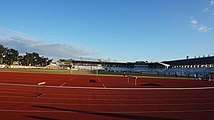
The city hosts a number of event centers which allow the city to host many provincial and regional gatherings such as the Cagayan Sports Complex, Tuguegarao City Peoples' Gymnasium and the Cagayan Coliseum.
The water system of Tuguegarao is administered by the Metropolitan Tuguegarao Water District, which also serves the nearby municipalities such as Iguig and Solana. Meanwhile, electric services are provided by Cagayan Electric Cooperative which has its office in Solana, Cagayan. Telecommunication services are primarily offered by huge telephone companies such as PLDT and Bayantel, while mobile services are handled by Globe Telecom, Smart Communications, Sun Cellular, Touch Mobile, and Talk N' Text. High-speed DSL and optical Internet subscriptions are offered by RBC Cable, PLDT and Globe Telecom.
Tuguegarao City houses the headquarters of the Philippine National Police in Cagayan Valley in Camp Marcelo A. Adduru in Alimannao Hills. As the region's institutional center, it is home to the majority of regional government offices concentrated in the Regional Government Center, Barangay Carig Sur.
Transportation
Transportation and infrastructure plays a major role in keeping the Tuguegarao's economy up and running and nearby towns in play. Due to continued growth, daytime population in the city has increased with primary reasons for commuting for commerce, work and notably education due to the city's being known for having several institutions. Over the years, Tuguegarao evolved, expanded and grew, so did its transportation network to keep up with the growing demands of people for ease of access to reliable methods and transit flexibility.
Air
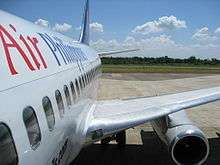
The Tuguegarao Airport handles domestic flights within the Philippines and serves the general area of Tuguegarao and its surrounding municipalities, and is capable of handling Boeing-737-sized aircraft. It is one of the top 20 busiest airports in the country and classified by the Civil Aviation Authority of the Philippines as a Principal Class 1 domestic airport. Cebu Pacific, Sky Pasada and PAL Express are the domestic airlines which operate routes to and from the city. As of 2017, the airport is undergoing rehabilitation and expansion consisting of terminal upgrades and widening of runway, for night landing capabilities, and taxiway.[60]
A proposed international airport, serving the Cagayan Valley Region, will be constructed at the eastern portion of the city—somewhere in barangays Dadda or Tagga—as suggested by City Mayor Bienvenido de Guzman II and former mayor Atty. Jefferson Soriano. Originally, as proposed by the Cagayan Governor Manuel Mamba, the airport was to be located at the tri-boundary area of Tuao, Piat and Solana towns but was later shelved after a forum.[61]
Land
A cultural icon of the Philippines with a unique design, Tuguegarao's tricycles offer shared vehicle for hire services for small groups of passengers on a common route over short distances.
Tuguegarao also serves as a vital hub for local, regional and national transportation. Buses operate regional routes from Tuguegarao to Baggao, Aparri, Santiago, and many neighboring cities, towns and municipalities. It also is an end-of-the-line stop for many coaches running inter-city and national routes mostly coming from Metro Manila such as GV Florida, Victory Liner, Dalin Bus Liner, Five Star, Pangasinan Solid North to name a few.
To the east side are vans that ply north and south Claveria, Santa Praxedes, Aparri, Santa Ana, Alcala, Lasam and Junction Luna, Abulug in Cagayan, Santiago, Roxas, Ilagan and Cauayan in Isabela, Luna and Kabugao in Apayao. There are also mini buses plying to Lasam, Allacapan, Claveria, Santiago and Roxas. Then to the west are jeepneys with routes to Iguig, Tuao, Enrile, Tabuk and Rizal in Kalinga and some mountainous barrios, all of which lie on the west side of the river.
Kalesas run within the city, mostly near popular points of interest, and are part of the city's tourism but most of these are limited within the downtown area. Taxis are the newest mode of public transportation which are routed from the city to any point in Region 2.
Main roads
Regional transport in Tuguegarao is vulnerable given its lack of distribution of arterial roads and inadequate traffic engineering planning and discipline.
- The Buntun Highway-Luna Street network is a major four-lane road network of Tuguegarao that forms part of the National Route 51 (N51). It is the only road that serves west-side traffic to Tuguegarao. It links Tuguegarao to the western side of the Cagayan River via the Buntun Bridge, further towns from the west side most notably the municipalities of Solana and Enrile, the Philippine highway network and the Santiago-Tuguegarao Road.
- The Balzain Highway-Cagayan Valley Road is another major four-lane road network of Tuguegarao, part of Cagayan Valley Road that comes through Balzain and Carig, that forms part of the Asian Highway 26 (

- The Tuguegarao City West Diversion Road is an 8.99 km (6 mi) four-lane road under construction which starts from Barangay Carig traversing Barangays Linao, Atulayan, Bagay and Buntun, aiming to decongest the Tuguegarao highway and provide alternative routes to nearby municipalities like Solana. The road project is divided into four phases expected to be completed by 2022.[62]
Healthcare
Being the regional center, Tuguegarao hosts major hospitals which serve people in the Cagayan Valley region. Cagayan Valley Medical Center, the largest medical facility in the Cagayan Valley with a bed capacity of 500, is situated in the city. The largest privately owned facility in the region is the 250-bed Dr. Ronald P. Guzman Medical Center, a tertiary level hospital.[63] St. Paul University Philippines has an affiliate hospital in Tuguegarao, the St. Paul Hospital. Cagayan's oldest existing private hospital, the Dr. Domingo S. De Leon General Hospital, formerly Clinica De Leon, is also situated in the city.
Other hospitals in the city are the government-owned and run Tuguegarao City People's General Hospital and the Holy Infant Hospital[63] as well as the privately owned Divine Mercy Wellness Center.[64]
Education
Due to its high incidence of universities, Tuguegarao has been dubbed as the Center of Education in Cagayan Valley. It is home to prestigious and internationally recognized schools such as St. Paul University Philippines — the main campus of the St. Paul University System — and the University of Saint Louis Tuguegarao — one of the CICM schools. Ateneo de Tuguegarao, the country's fifth Ateneo ran by the Society of Jesus, was established in 1945 but eventually closed in 1962 with the Jesuit exodus.
Two of the top state universities are also in Tuguegarao City — the CSU Athena (Andrews Campus), and CSU Red Eagle (Carig Campus) — producing national topnotchers in board examinations. Both universities have their own administration and are separated from each other.
Other schools in the city include the University of Cagayan Valley, John Wesley College, Medical Colleges of Northern Philippines - International School of Asia and Pacific, F.L. Vargas College, Maila Rosario College, Credo Domine College, City Technological Institute, Cagayan Metropolitan Institute of Technology, STI College, AMA Computer College, and other educational institutions.
The Technical Education and Skills Development Authority (TESDA) was established through the enactment of the Technical Education and Skills Development Act of 1994, which encourages the full participation of and mobilize the industry, labor, local government units, and technical-vocational institutions in the skills development of the country's human resource. The TESDA complex and facilities are located in Carig Norte. Numerous technological and vocational institutes can also be found in the city.
Tuguegarao has one Jesuit educational institution located along Bagay Road—the Global Reformed University.
Other notable schools in the city include Cagayan National High School, the oldest and biggest secondary school in the region in terms of student population, Tuguegarao City Science High School, a state-owned secondary institution, Ke Bing School, a private Chinese school, Methodist Christian School, a Christian school in Central Business District, and Saint Claire Montesorri, a catholic school in San Gabriel. The state-owned secondary institution of Tuguegarao City West High School started operations on June 4, 2012.
Students from different countries like China, Congo, India, Nepal, Nigeria, Pakistan and South Korea come to study at the city's universities. Most of the students come to study undergraduate and graduate degrees in sciences.
Notable people
- Rommel Adducul, former professional basketball player and coach
- Ricardo Baccay, Archbishop elect of the Archdiocese of Tuguegarao, former third bishop of the Diocese of Alaminos, and former auxiliary Bishop of the Archdiocese of Tuguegarao.
- Eulogio Balao, former soldier and politician
- Philip Butel, Caloocan Supremos basketball player
- Rachelle Anne Cabral, archer in the 2012 Summer Olympics
- Noel A. Coballes, retired Lieutenant General and Commanding General of the Philippine Army (2013-2014)
- Ralph Guzman, broadcaster and journalist
- Benito Antonio T. de Leon, retired AFP military officer
Gallery
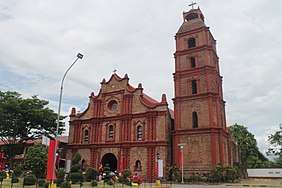
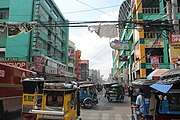 Mall of the Valley (Tuguegarao City Commercial Center)
Mall of the Valley (Tuguegarao City Commercial Center) Luna Street Tuguegarao
Luna Street Tuguegarao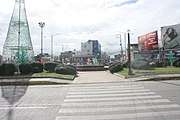 Tanza Crosswalk
Tanza Crosswalk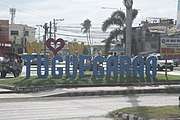 Tuguegarao Standee
Tuguegarao Standee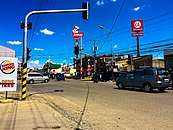 Buntun Highway Intersection
Buntun Highway Intersection
References
- "City". Quezon City, Philippines: Department of the Interior and Local Government. Retrieved 30 May 2013.
- "Province: Cagayan". PSGC Interactive. Quezon City, Philippines: Philippine Statistics Authority. Retrieved 12 November 2016.
- Census of Population (2015). "Region II (Cagayan Valley)". Total Population by Province, City, Municipality and Barangay. PSA. Retrieved 20 June 2016.
- "PSA releases the 2015 Municipal and City Level Poverty Estimates". Quezon City, Philippines. Retrieved 1 January 2020.
- "Cagayan Valley Regional Development Plan 2017-2022" (PDF). NEDA.gov.ph. National Economic and Development Authority Regional Office 02. 2018-01-19. Retrieved 2020-06-14.
- "Reasons to Invest". www.rdc2.gov.ph.
- Dullana, Raymon. "Tuguegarao records coldest temperature, so far, for 2018". Rappler. Retrieved 2019-03-24.
- (2013-04-04). "PAGASA: Hottest day so far this year in NCR at 35.2 degrees Celsius". GMA News Online. Retrieved on 2013-08-02.
- Corrales, Nestor (April 26, 2014). "Tuguegarao City records hottest temperature–Pagasa". Philippine Daily Inquirer. Retrieved March 24, 2019.
- "History". Tuguegarao City Official Website.
- Taken from the city's official website as written by Maria Fe B. Agu-Villania, CPA, CSEE, the City's Planning and Development Coordinator
- "An Act Creating the Barrio of Capatan in the Municipality of Tuguegarao, Province of Cagayan". LawPH.com. Retrieved 2011-04-13.
- Times, Special to The New York (1990-03-05). "14 Die as Philippine Troops Fight Rebel Governor". The New York Times. ISSN 0362-4331. Retrieved 2020-05-12.
- "Attempt to Arrest Governor Tied to Coup Attempt Leaves 14 Dead". AP NEWS. Retrieved 2020-05-12.
- Lagasca, Charlie. "Tuguegarao City, a Ting stronghold, has new mayor". The Philippine Star.
- "Tuguegarao City". Department of Tourism - Region 2.
- "Province of Cagayan Website :: GEOGRAPHY". cagayano.tripod.com.
- "Barangays".
- "March Climate History for Tuguegarao". myweather2.com.
- "April Climate History for Tuguegarao". myweather2.com.
- "From hottest in PH, temperatures drastically drop in Tuguegarao". Manila Bulletin. Retrieved 2019-03-24.
- Gascon, Melvin (January 27, 2014). "Tuguegarao, hottest city in PH, also chills". Philippine Daily Inquirer. Retrieved March 24, 2019.
- "Tuguegarao City, Cagayan Climatological Normal Values". Philippine Atmospheric, Geophysical and Astronomical Services Administration. Archived from the original on 18 October 2018. Retrieved 18 October 2018.
- "Tuguegarao City, Cagayan Climatological Extremes". Philippine Atmospheric, Geophysical and Astronomical Services Administration. Archived from the original on 18 October 2018. Retrieved 18 October 2018.
- "Station 98233 Tuguegarao". Global station data 1961–1990—Sunshine Duration. Deutscher Wetterdienst. Retrieved 18 October 2018.
- Station ID for Tuguegarao is 98233. Use this station ID to locate the sunshine duration
- Census of Population and Housing (2010). "Region II (Cagayan Valley)". Total Population by Province, City, Municipality and Barangay. NSO. Retrieved 29 June 2016.
- Censuses of Population (1903–2007). "Region II (Cagayan Valley)". Table 1. Population Enumerated in Various Censuses by Province/Highly Urbanized City: 1903 to 2007. NSO.
- "Province of Cagayan". Municipality Population Data. Local Water Utilities Administration Research Division. Retrieved 17 December 2016.
- "Tuguegarao City History | Tourist Spots, Language and Festivals | Philippines Cities". Retrieved 2019-03-20.
- "NEXT WAVE CITIES IN THE PHILIPPINES". nicp.org.ph. Retrieved 2019-03-11.
- Dela Cruz, Raymond Carl (June 30, 2020). "25 PH cities chosen to be next 'digital cities' by 2025". Philippine News Agency (PNA). Retrieved July 3, 2020.
- SM Prime Holdings Offer Supplement 2017. p. 30-31. SM Prime Holdings, Inc.'s Application for Permit to Sell
- "SM Prime Building 21 New Malls". Manila Standard. Retrieved 2019-03-12.
- "SMPH T4 : Updated Offer Supplement" (PDF). SM Prime. SM Prime Holdings, Inc. March 14, 2019. Retrieved March 20, 2019.
- Dumlao-Abadilla, Doris. "RLC to generate P20B through share sale". Philippine Daily Inquirer. Retrieved 2018-06-01.
- "Robinsons Land opens 50th mall". BusinessWorld. Retrieved 2018-07-20.
- Philippine Daily Inquirer. "RLC bets big on warehousing, dorms, coworking spaces". Philippine Daily Inquirer. Retrieved 2018-06-01.
- "Philippine Seven steps up expansion after robust 2017 results". Manila Bulletin. Retrieved 2019-03-12.
- "Tuguegarao City meet with IT-BPO players". region2.dti.gov.ph. Retrieved 2019-03-11.
- "Tuguegarao City to advance local ICT industry". Philippine Information Agency. Retrieved 2019-03-11.
- "1st business park to rise in Tuguegarao City". BusinessWorld. 2020-02-04. Retrieved 2020-04-13.
- "North Gateway Business Park – DataLand Projects". Retrieved 2020-04-13.
- "Local Government Code of 1991". The LawPhil Project.
- "Tuguegarao mayor Soriano steps down to focus on court fight". Rappler. Retrieved 2017-02-10.
- Dullana, Raymon. "CA division reinstates Tuguegarao mayor Soriano". NorthernForum.net. Retrieved 2017-09-06.
- "2019 Election Results:Tuguegarao City, Cagayan". GMA News. Retrieved 22 May 2019.
- Gascon, Melvin. "Tuguegarao mounts fire festival". Philippine Daily Inquirer. Retrieved 2014-08-18.
- Dullana, Raymon. "Take a look at Tuguegarao's vibrant 'fire' festival". Rappler. Retrieved 2016-08-13.
- Dullana, Raymon. "3,500 students light torches for Tuguegarao's 'Afi' Festival". Rappler. Retrieved 2017-08-13.
- PNA. "Tuguegarao hosts Pav-vurulun Afi fest". Manila Standard. Retrieved 2016-08-07.
- Albornoz-Lactaoen, Vic (2007-08-17). "Maskota Festival of Tuguegarao City". Manila Bulletin.
- "Pancit Batil Patong - Ang Sarap". AngSarap.net. Retrieved 2019-05-27.
- Sison, Jainey (2017-06-06). "Longganisang Tuguegarao". Mama's Guide Recipes. Retrieved 2020-05-12.
- "New Cagayan museum 'soft opening' eyed for Aggao nac Cagayan 2018". The Northern Forum. 2018-04-03. Retrieved 2020-04-30.
- "PAGGUNITA NG SENTENARYO NG BANTAYOG NI GAT JOSE RIZAL SA TUGUEGARAO, MATAGUMPAY NA IDINAOS". Cagayan. Retrieved 2020-04-30.
- "Tuguegarao City's long neglected horno". Simbahan. 2016-01-15. Retrieved 2020-04-30.
- "HISTORY". St. Paul University Philippines. Retrieved 2020-04-30.
- "Best Things To Do In Tuguegarao, Philippines For Adventure Seekers - Updated 2020". Trip101. 2017-05-13. Retrieved 2020-04-30.
- Dela Paz, Chrisee Jalyssa V. "Tuguegarao airport expansion, rehab contracts announced". BusinessWorld. Retrieved 2017-10-03.
- Lucena, Gerard Josef. "New int'l airport site seen in eastern Tuguegarao". NorthernForum.net. Retrieved 2017-08-22.
- Iñigo, Liezle Basa. "P1.1B Tuguegarao diversion road being built". Manila Bulletin. Retrieved November 9, 2018.
- "Members". www.phap-ph.org.
External links
| Wikivoyage has a travel guide for Tuguegarao. |
| Wikimedia Commons has media related to Tuguegarao City. |



